Civilization of Sophia: An Exhibition in Kyiv Explores Ukrainian and Russian Dimensions of War and Peace

Perhaps it is indeed easier for many to toss Russian books into the recycling bin or say "goodbye" to a Pushkin monument than to stop making "Olivier" salad on New Year's Eve, reminiscing about "free healthcare" or the "world's best" ice cream. All the while, they may not realize how these deeply ingrained habits still pull them back—toward another cycle of Russification.
What is this devouring Russian-Soviet world like? Why are the Russian-Soviet and Ukrainian worlds fundamentally incompatible? The multimedia project "Guarding Saint Sophia" sheds light on these and other questions.
Opposition of Dimensions
The exhibition's title is rich with multiple layers of meaning. “Sophia primarily symbolizes wisdom and embodies the virtues of Faith, Hope, and Love—qualities that Ukraine direly needs today,” explains Vitaliy Nakhmanovych, the project's creator and chief curator, who is also a leading researcher at the Museum of the History of Kyiv. “It also represents Saint Sophia Cathedral, a symbol of the unified Church since the Baptism of Volodymyr, and alludes to Sophia Square, which has served as Kyiv’s public forum for centuries, much like Maidan.” Together, these dimensions intricately weave the narrative of Ukrainian civilization.
In a sort of "prologue" to the exhibition, the opposition between Ukraine and Russia is framed not merely as a conflict between two nations or states but as a clash of fundamentally different dimensions: light versus darkness and a creative civilization opposed to one that is oppressive and imperialistic. This understanding clarifies the nature of the ongoing war, which is far from being the first of its kind.
Ukrainian civilization is presented as a continuous entity, extending from the era of Kyivan Rus to the present day. "We intentionally skip the long gaps in the existence of an independent Ukrainian state," explains the exhibition's curator. "Instead, we emphasize that today’s Ukraine is the direct successor to the Principality of Kyiv, and Cossack states its restoration during the Ukrainian Revolution and the efforts to revive it during World War II. The lengthy intervals between these periods are incidental to us. What truly matters is that the Ukrainian state has existed for over a thousand years.”
The author of the exhibition chose not to follow a chronological order. Instead, he created a world of images and meanings. The three sections of the exhibition feature a variety of photos, videos, and artifacts from different historical periods. Behind each one lies a specific story, like a puzzle piece or a small tile in a mosaic. Together, they form a cohesive representation of a particular phenomenon.
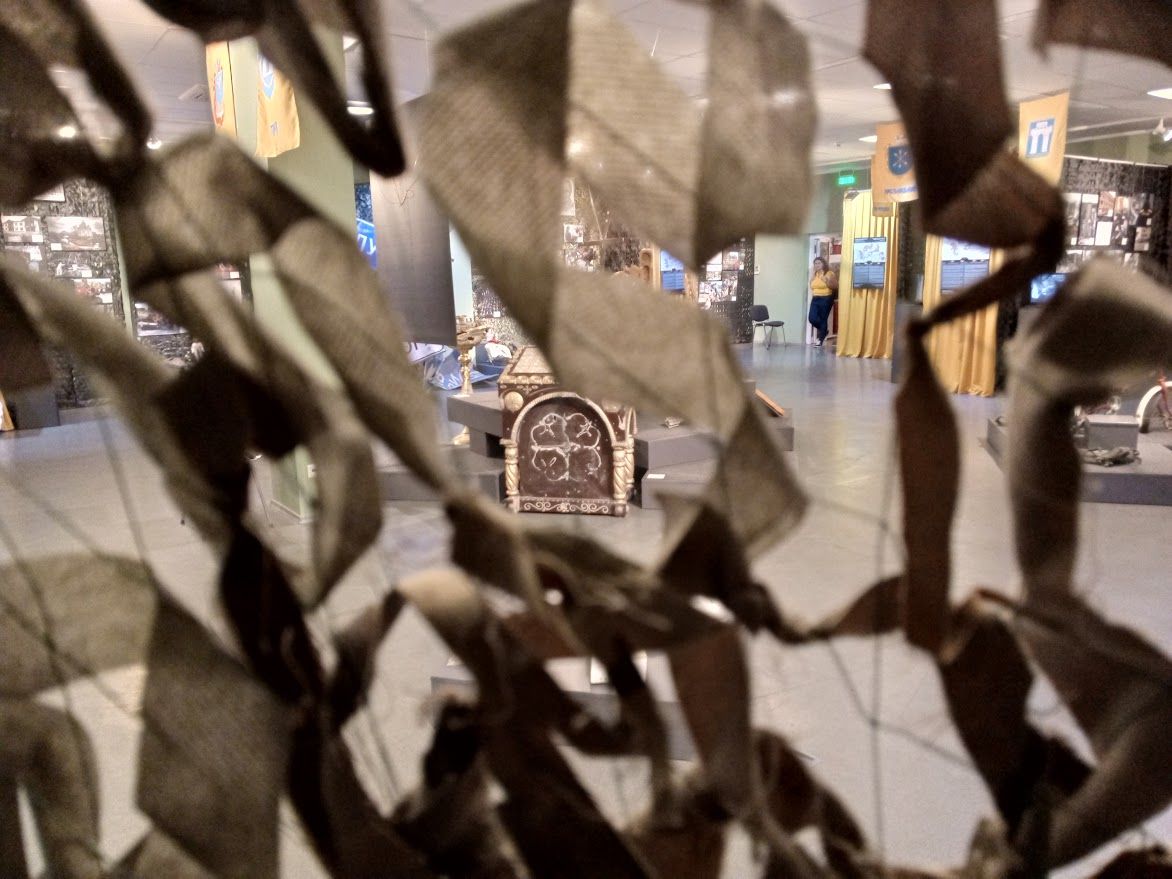
Money or Nostalgia?
"Recently, I came across insights into the motivations of those who set military vehicles on fire," shares Vitaliy Nakhmanovych. "These individuals are typically either young, around 20-22 years old, or older, over 40. Alongside their pursuit of easy money, both groups exhibit a nostalgia for Soviet times. Interestingly, most of them either never lived in the 'Land of the Soviets' or were just children during that era. After all, we have been living in an independent country for over 30 years. Many have no firsthand experience of life in a radically different country. Despite this, a notable number still harbor a positive image of the Soviet Union. Some of these nostalgic individuals go on to become spies, informants, and saboteurs, harming our country not just for financial gain. This reality poses a significant danger."
This project seeks to remind ordinary citizens of the "small joys" of the Soviet Union while clearly illustrating the contrasting approaches to life, culture, faith, and power between these two distinct worlds.
The exhibition is divided into three thematic sections: "Ukrainian Civilization," "Russian Civilization," and "The Defense of Kyiv." Each section is structured across three vertical levels. The lower level showcases artifacts, the middle level displays photographs and videos, and the upper level features notable historical figures.
Our Lifeline
In the first hall, the "Yellow Hall," the continuous thread of Ukrainian civilization from the era of Kyivan Rus to the present is vividly illustrated. It showcases the wealth of creativity, intellect, and beauty, along with the development of crafts, inventions, industry, science, the church, arts, and education during times of peace. This "lifeline," represented through photos, artifacts, installations, and thematic displays, is interspersed with illustrations of the destruction caused by Russian wars.
"The war we are witnessing today is not an isolated historical event for Ukraine," Nakhmanovych points out. "It is a recurring struggle, and each time we fight to reclaim the peaceful, creative life that war inevitably disrupts."
One notable display, "History of Science and Technology," is located alongside the section on the history of the Ukrainian Church. "In common thinking, science is often viewed as opposing religion," the historian explains. "But these are simply different dimensions of intellectual and spiritual human pursuits. In normal civilizations, they are not at odds; rather, they complement each other, working toward the same goal in different ways."
Religion is represented through artifacts such as old printed books, religious relics, and photographs. One notable image captures U.S. President Joe Biden during his visit to the St. Michael's Golden-Domed Monastery.
Between the displays on science and faith is an exhibition space dedicated to Ukrainian aircraft manufacturing and astronautics. This is likely no coincidence, as Ukrainians have always been captivated by the sky. Among the exhibits is a collection of aircraft models designed by the Oleg Antonov Design Bureau.
Strength for Guardianship
At the heart of the Ukrainian hall is an installation that, as the curator describes, embodies the essence of Ukraine and inspires the strength to safeguard it. This essence is captured in the dual themes of faith and the aspiration for freedom. Representing faith is a double-sided 19th-century banner featuring "The Mother of God of the Sign" and "Saint Nicholas." In contrast, relics from the Orange and Euromaidan Revolutions symbolize the enduring quest for freedom.

Separate display cases showcase Ukrainian music and arts, particularly folk art, highlighting their development from the beginnings of statehood to the present. One case is dedicated to Ukrainian literature, featuring a bronze stylus from the Kyivan Rus era, a Cossack ink pot, writing instruments from the 19th century, and a typewriter from the 20th century. Also on display is a rare original edition of the novella "Fata-morgana" by Mykhailo Kotsiubynsky, along with proofs of his story "The Dream," complete with the author’s dedication and personal edits.
One section of the exhibition focuses on the state and governance in Ukraine, which are not self-sufficient. "The images of public demonstrations are equal in number to the portraits of state leaders," notes the exhibition curator. "Moreover, these leaders are presented in a completely informal manner—as real people in various situations." There are also somewhat caricatured plaques of Kyiv princes created by artist Halyna Sevryk.
In the upper area of the Yellow Hall, portraits of cultural, religious, scientific, and human rights figures are displayed. "The Ukrainian state exists not for its own sake, as the Russian and Soviet states do," the historian summarizes. "Rather, it exists solely to ensure the development of Ukrainian civilization, and these individuals personify that civilization."
Kyiv Chronicles
A separate exhibition in the "Yellow Hall" is dedicated to Kyiv. It consists of four sections: the city, daily life, decolonization, and the metro. The first thing we see here is toys from a Kyiv high-rise that was the first to be destroyed. Numerous photos on the walls, among scenes of ruins and fires, intersperse snapshots of everyday life from both the past and present of Kyiv residents. One photo depicts a park with benches where people sit and read. Nearby is an image of an elderly woman with a walker, waiting for firefighters to extinguish the flames from a missile strike on her home. There are peaceful gatherings by a fountain in Maidan and volunteers packing humanitarian aid.
The phenomenon of decommunization in the capital is represented by removed, now unnecessary signs bearing the names of streets: "Prospect of the Red Dawn," "Gorky Street," "Rosa Luxemburg," "Ilyich," "Zhukov," and more.
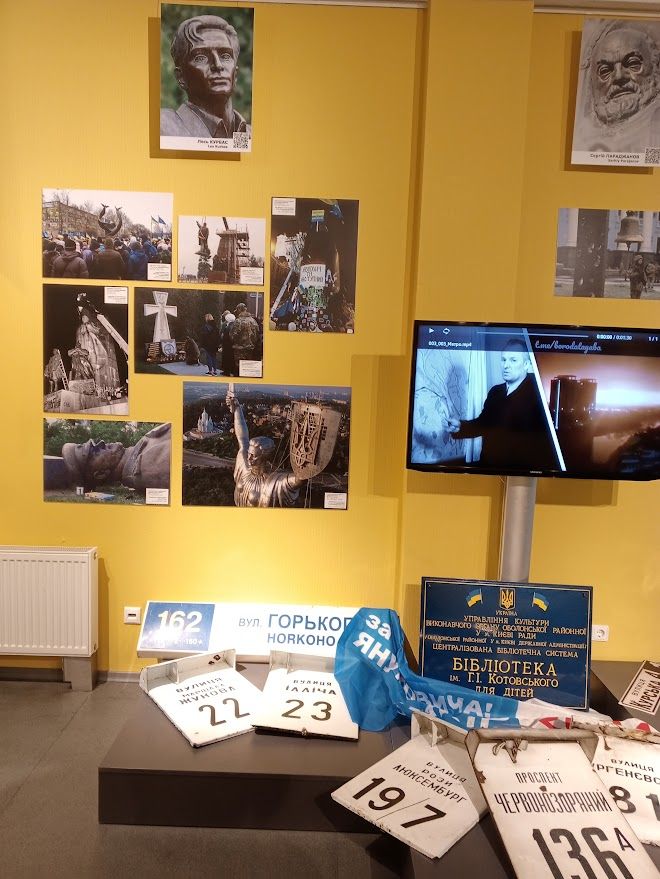
Another part of the exhibition is dedicated to the Kyiv metro, which became a refuge for residents at the onset of the full-scale war. One photo shows the "Syrets" station on March 19, 2022. A little girl walks through it with her father, who has a blue territorial defense armband on his arm. To the left is a long row of tents set up in the space between the platforms.
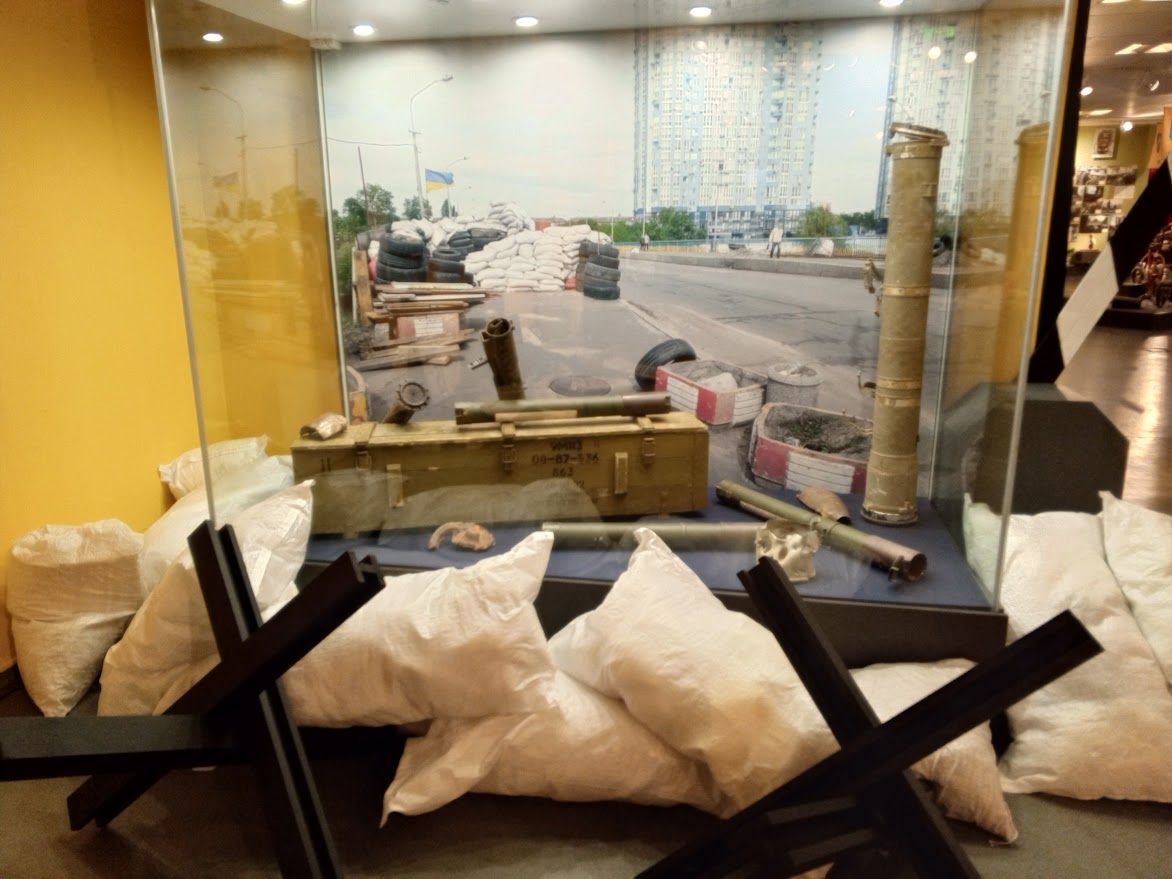
90 Seconds before the End?
Visitors to the exhibition exit the hall of Ukrainian civilization through what appears to be a checkpoint. The space of light, peaceful Kyiv, and the opulent Ukraine is left behind. Ahead lies a world glowing ominously red. At the boundary of these worlds is a large clock face: the Doomsday Clock. This project, initiated in 1947, is managed by the American magazine Bulletin of the Atomic Scientists based in Chicago (USA). Every January, based on analytical data about the global situation, the magazine's board of directors, along with esteemed experts and Nobel laureates, set the symbolic time on the clock, indicating how close humanity is to midnight, or the start of nuclear war. In January 2023, the time was set at one and a half minutes to midnight. This year, the minute hand remains in the same position.
“The war waged by Russia against Ukraine has effectively placed the world on the brink of nuclear catastrophe,” sums up Vitaliy Nakhmanovych. “It is crucial to recognize the responsibility of our allies for what is happening. This responsibility often frustrates us, but it explains their caution regarding a much more terrifying global disaster.”
However, Ukraine has already faced nuclear danger both in 1986 and now. Moving away from the symbolic clock, we see particularly striking photos: Russian trenches in the Rudyi Forest near the Chernobyl Nuclear Power Plant in March 2022, and an image from 1990 showing residents of the 30-kilometer zone leaving their homes.
State of Blood-Stained Labor
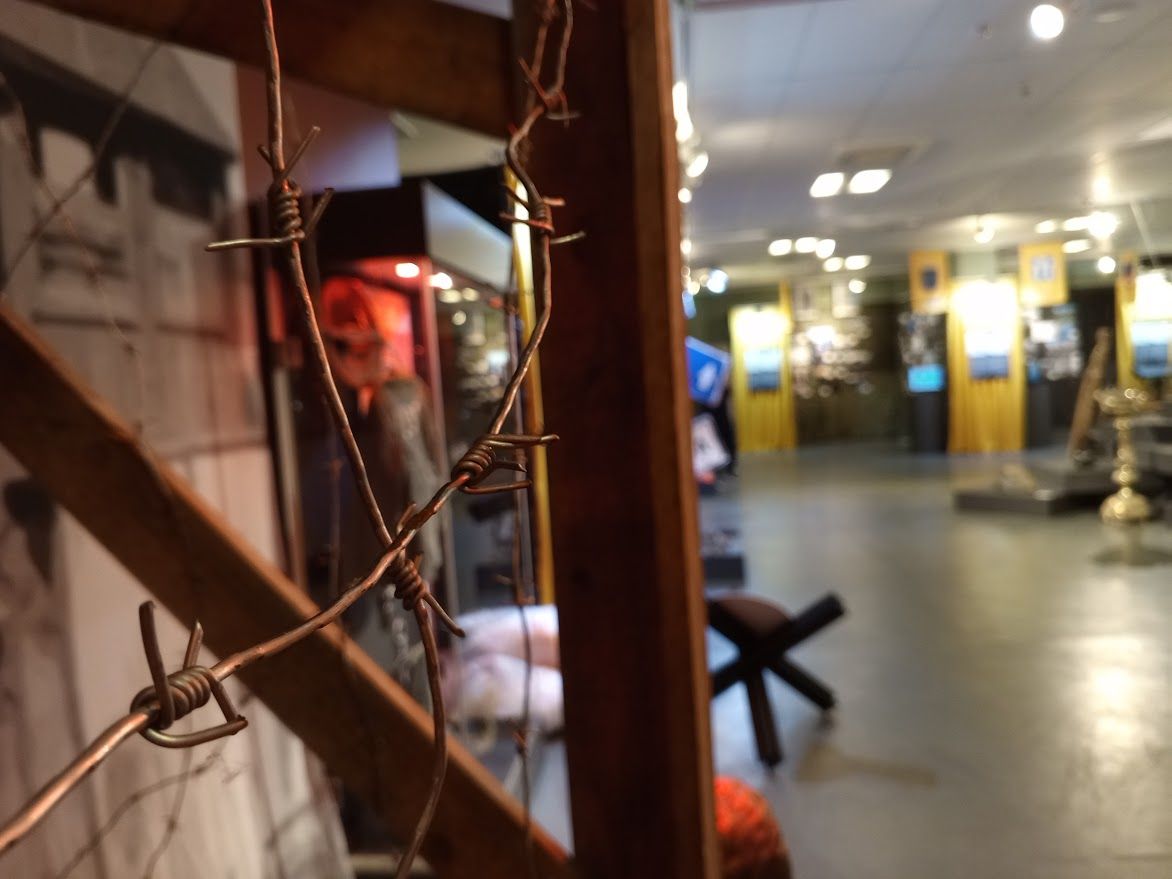
In the "Red Hall," the causes of the Russian war are revealed in a metaphorical form. The first thing that catches the eye at the entrance to this “cave” is a warning about danger. The entrance is designed to resemble the gates of a concentration camp, wrapped in barbed wire. Above them hangs a blasphemous slogan: “Labor is a matter of honor, of glory, valor and heroism.” This phrase was displayed in all Soviet "corrective labor" facilities and remains relatively unknown to the general public, in contrast to a similar slogan from Nazi concentration camps—“Arbeit macht frei.”
At the gates to this inhospitable “hub of happiness,” we are greeted by its founding figures: Lenin and Stalin.
The path through the gates follows the letter Z, laid out as if made from strips of the Russian tricolor. It bears the dirty footprints of military boots from prisoners of the Russian-Soviet concentration camp. They lead outward as if the owners of these boots are pushing through the gates to turn everything around us into a concentration camp.
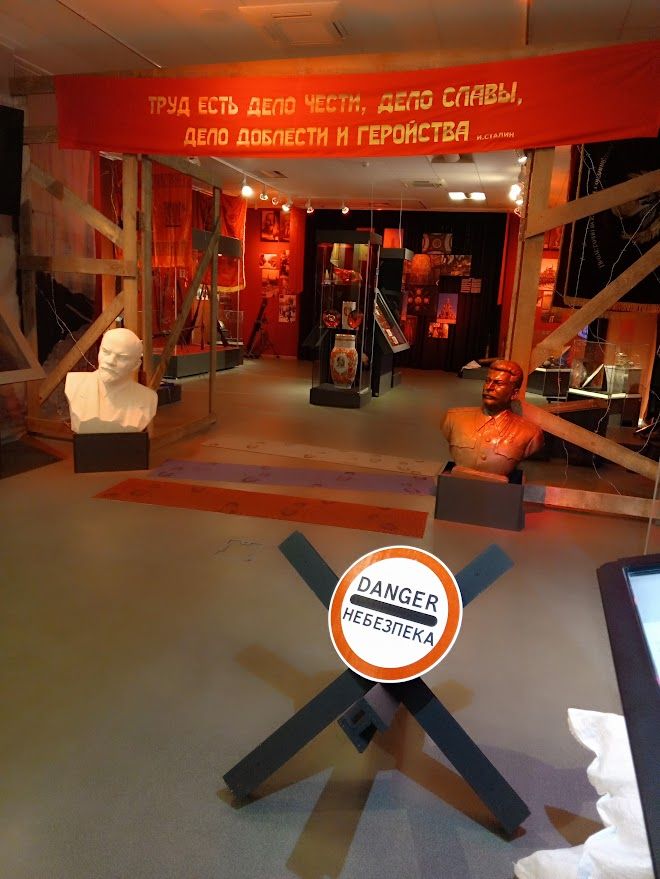
“The image of Russian-Soviet civilization is, in fact, very simple. It is a cult of the military, aggressive wars, repression, a state for the sake of the state,” explains Vitaliy Nakhmanovych. “This is represented in photographs, videos, and artifacts. Above, we see portraits of their ‘leaders’—from Nicholas II to Vladimir Putin. Unlike our figures, who are represented by monuments existing in the living memory of the people, Russian leaders appear like posters from Soviet parades and demonstrations. We are showing the true essence of these otherworldly beings from hell.”
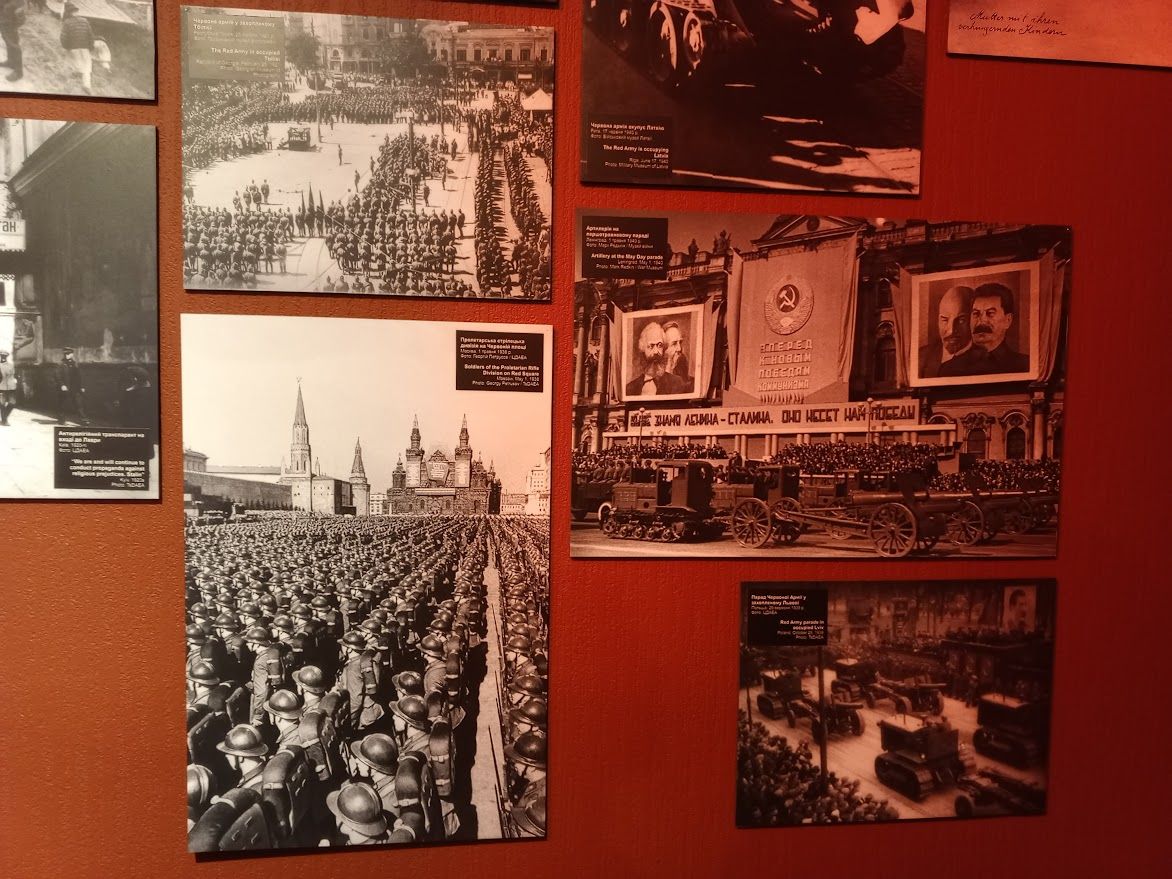
In the Temple of War
On two stands glimmer Russian imperial and Soviet medals and currency. At the center of the section dedicated to civil awards is the medal “For Diligence.” This is hardly surprising, as enthusiasm and diligence were the main “virtues” of the population in the “Land of the Soviets.” The second stand displays awards from various colonial wars, ranging from the early days of Muscovy to the 20th century. The centerpiece here is the dirhams of the Golden Horde. These small, battered coins indicate the true origins of this strange state, which tries so hard to link itself to Kyivan Rus, despite having no organic connection to it.
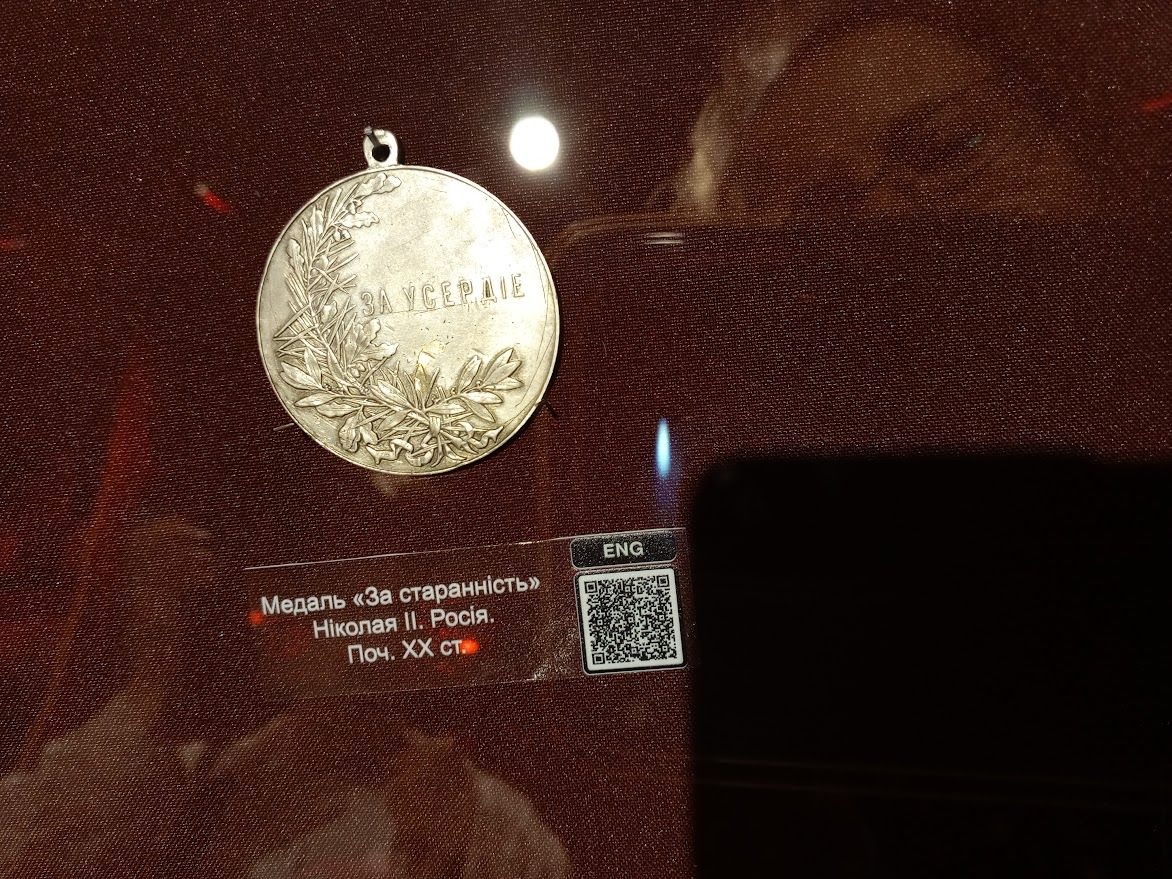
The attention in this hall is also drawn to information about the main cathedral of the armed forces of the Russian Federation, built two years before the full-scale invasion of Ukraine. This so-called Temple of Victory encapsulates the ideology, values, and meaning of the centuries-old Russian-Soviet civilization. Its bell tower stands at 75 meters, commemorating the “75th anniversary of Victory in the Great Patriotic War.” Seventeen bells are dedicated to the various branches and types of the Russian military.
“It is presented as a Christian temple, but in essence, it is entirely pagan,” emphasizes Vitaliy Nakhmanovych. “It evokes associations with some kind of shrine to the gods of war throughout the ages, where human sacrifices are offered. This is the ideological root of the ‘Russian world.’”
Candle Extinguished by a Rocket
“The clash of the ‘Temple of Victory’ with St. Sophia of Kyiv results in this,” says Nakhmanovych, pointing to the central composition of the third “Green Hall.” It represents a destroyed church. Here, we see shattered church bells and icons. At the center is the image of St. Nicholas from the destroyed Ascension Church in the village of Bobryk, which was obliterated on March 5, 2022. Surrounding it are artifacts from churches in Kyiv and other regions, including a crumpled candlestick from the Transfiguration Cathedral in Odesa, ruined by a Russian missile.
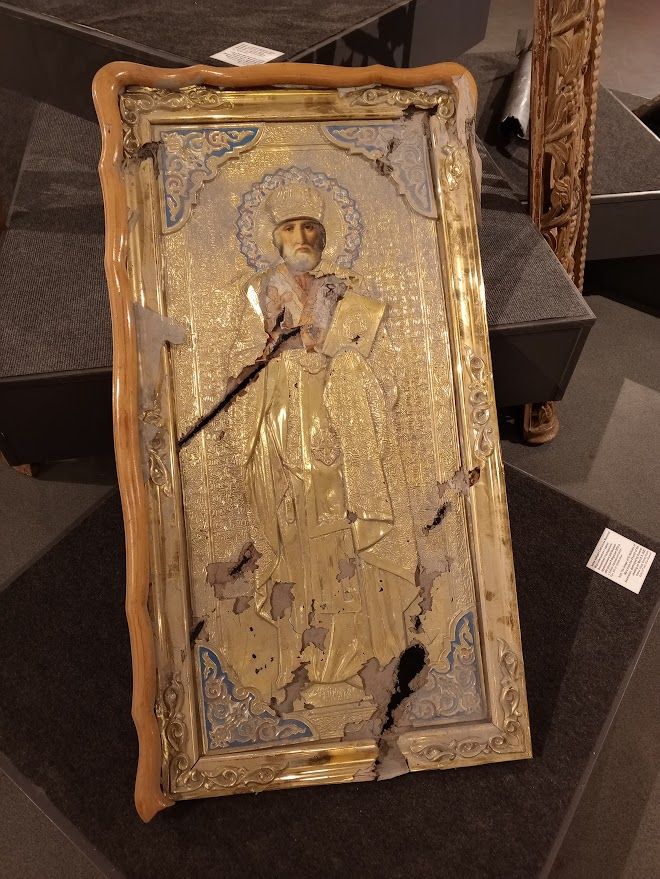
This hall is dedicated to the defense of the capital. It showcases the devastating consequences of the occupation of the Kyiv region and the crimes against humanity committed by Russian troops in key defense cities and villages like Irpin, Bucha, and Moshchun. Yet, we also sense a breath of renewal and hope, as seen in one photograph of a liberated village, where a proud rooster strides through the debris-strewn courtyard, cluttered by the occupiers.
This hall of occupation and struggle is seemingly entangled in camouflage gray-green netting. Its exhibition symbolizes the entire Russo-Ukrainian war. On pedestals before it, we find numerous traces of the occupiers’ presence in our land: clothing, packaging from military rations, canned goods, and a mass of missile and drone fragments. Amid this grim backdrop, colorful spots appear—dolls dressed in Ukrainian attire, symbolizing the Ukrainian men and women with living souls and loving hearts who resist the deadening Russian onslaught.

Separating the Wheat from the Chaff
The exhibition features artifacts from the collections of the Museum of the History of Kyiv and the National Museum of the History of Ukraine in World War II. Staff from these museums, along with specialists from the Center for Military History Research of the Armed Forces of Ukraine and other partners, collaborated on the exhibition. The concept arose in Vitaliy Nakhmanovych’s mind in the spring of 2022, following the Battle of Kyiv, when people began to return to their normal lives. “First and foremost, I set myself the task of showing all the cause-and-effect connections of this war,” emphasizes the project curator, Vitaliy Nakhmanovych. “After all, many people still do not understand them and pose the rhetorical questions: ‘Why? For what?’” That summer, the historian began working on the “Chronicles of the Defense of Kyiv,” and by December, the work on the project itself commenced.
Thus, the exhibition “Guarding Saint Sophia” can be accessed in the Exhibition Hall of the Museum of the History of Kyiv (Bohdan Khmelnytsky St., 7) throughout the year.
The exhibition answers many of our questions. However, it poses one that almost no one knows the answer to: How to overcome nostalgia for the “red” times in many people? How to separate in their memory the warmth of a home with a “lying” radio from what it broadcasted? Or the first kisses of young lovers from the monument to Felix Edmundovich under which they sat? The joyful “Alphabet Holiday” for first-graders from the images in it: with Moscow, tanks, and airplanes? How to say goodbye to the bloody shackles that insidiously drain humanity from a person while still holding onto one’s childhood and youth, as well as keeping at heart one’s vivid and warm family stories?
##DONATE_TEXT_BLOCK##









